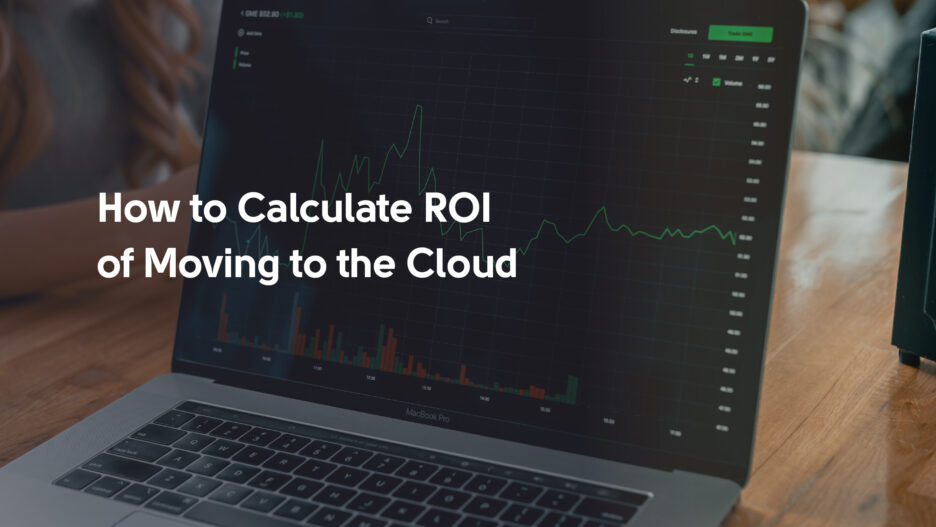Cloud computing has given businesses new capabilities to increase the speed, scale, and cost of doing business — with cloud-powered companies now being among the most valuable in the world.
Naturally, most leaders also expect to capture the much-sung cloud benefits:
- Faster time-to-market for new digital products
- Instant scalability and flexible resource provisioning
- Improved team collaboration and communication
- Business continuity and data loss prevention
- Centralized access and data security
- Better total cost of ownership (TCO) for infrastructure
- Business model evolution and higher competitiveness
Yet, not all companies get to experience these first-hand. Only half of businesses, surveyed by PwC, said to have realized the target outcomes: cost reduction, higher resilience, and increased revenue among others.
Why is there such a gap between the anticipation and the reality?
The answer often lies in how the companies measure the return on investment (ROI) for cloud projects.
What is the ROI of Moving to a Cloud?
Cloud migration is often associated with cost savings through shifting from CAPEX to OPEX expenditure. In simpler terms: replacing an on-premises data center (and all associated capital costs) with demand-driven, usage-based pricing. Depending on the project scale, the ROI of cloud hosting vs. on-premises hosting alone can be rather significant.
.jpg)
However, the “cost savings” aspect of ROI can be also negated by the significant monthly public cloud bill, which often goes beyond the initial financial projections. In fact, some 37% of public cloud users faced unexpected costs in 2022.
Here’s the deal about cloud ROI: comparing cloud vs. on-premises infrastructure costs alone doesn’t provide an accurate representation of the obtained end value.
To get an accurate estimate, you need to also include ancillary benefits such as:
- Improved operational performance
- Higher business agility
- Lower environmental impacts
For example, our client, Mueller Water Products, not only achieved license cost reduction after migrating to the AWS cloud but also substantially improved overall staff productivity. Illumina, in turn, managed to substantially save on data storage costs, while also reducing its carbon emission levels by 89% with AWS.
In other words: a reasonable cloud computing ROI calculation has to factor in both direct and in-direct benefits to provide a more accurate representation.
How to Measure The ROI of Moving to the Cloud
To justify the cost of moving to the cloud, you’ll need to compare the cost of investment versus the future gains. Here’s how to do this:
Set the baseline
To answer the question of how moving to the cloud saves money, you need to understand your present-day spending.
In other words: You need to document the current state of affairs and model the future cloud-powered outcomes. As mentioned earlier, it helps to think across multiple ROI axes:
- CAPEX cost reductions
- Process optimization
- Reduced dependence on IT
- Faster time-to-market for new processes
Let’s say you want to migrate from on-premises to a cloud e-commerce system. In this case, you should first quantify the cost factors such as data center capital and maintenance expenses, new cloud subscription costs, and project implementation costs. This data is relatively easy to obtain from financial records and online cloud cost calculators.
But the benefits of cloud migration don’t just end with better TCO. A cloud e-commerce platform can also:
- Automate inventory management processes, which would save teams X work hours per week.
- Provide better marketing personalization solutions, which could increase average order value by Y%.
- Enable faster, more convenient checkout, which would increase conversion rates by Z%.
Using business analysis of different processes, you can estimate the current shortcomings in your processes and evaluate how the cloud might improve those.
In a similar vein, you should look into the risks which cloud migration could help eliminate including unplanned downtime, data loss, cybersecurity issues, and loss of competitiveness in the market.
Stack the costs against the benefits
Cloud migration assumes both one-time and ongoing operational expenses. Combined, they represent the total TCO for the migrated application(s) or workflow(s).
Investments
| One-time cloud migration costs | Ongoing cloud operating costs |
| Implementation and consulting fees | Subscription pricing |
| Data migration | Labor costs |
| Integrations and testing | Employee training |
| Extra tooling/software purchases | Cloud administration and maintenance |
These costs are relatively easy to estimate in monetary equivalent using historical data, industry benchmarks, and internal business analysis.
Apart from being a new cost center, cloud adoption also offers opportunities for cost consolidation. You can retire aging on-premises infrastructure, save on data center maintenance costs, and assign employees, formerly dedicated to low-level hardware support tasks to higher value-work. These savings should be also factored into your cloud ROI calculation.
You should also apply the right time horizon for your ROI estimation. Cloud adoption brings both immediate and long-term gains for organizations.
Benefits
| Short-term | Long-term |
| Improved scalability | Reduced TCO |
| Higher product availability | Increased staff productivity |
| Stronger security | Faster disaster recovery |
| Greater system stability | Higher innovation potential |
| Faster software engineering | Strategic advantage over competition |
Popular cloud service providers offer calculators for measuring ROI. For example, Amazon’s Cloud Economics portal provides sample cost estimates and extra guidance for collecting 360-degree metrics worth measuring.
Apply the right cloud ROI formula
The cloud ROI formula we recommend using is this one:
ROI = ((Total cloud value – initial value of investment) ÷ cost of investment) x 100%
The total cloud value represents all the gains you expect to achieve from adoption — both direct and indirect ones including cost reduction, productivity gains, environmental savings, faster product engineering, etc.
Next, you should calculate one-time system implementation costs (i.e. initial value of investment) and ongoing spending on subscriptions, personnel, and cloud solution maintenance. Once you have the two numbers, apply the above formula to calculate the ROI of cloud adoption.
For extra context, here’s a sample ROI calculation for AWS Cloud Ops adoption from Forrester.
The analysis indicates that 5 interviewed AWS Cloud Ops adopters reported the following cumulative benefits over a three-year period:
- $3.1 million in operational savings thanks to faster deployment of workloads to production with AWS services
- $14.5 million in extra value enabled by faster application and feature development
- $7.8 million in prevented revenue losses due to reduced downtime
- $3.4 million in cost savings with better management of workloads
The total quantifiable benefits alone present a value of $28.8 million, while unquantifiable benefits such as higher workforce productivity, improved system security, and new skills development further increase the value number.
The implementation costs, in turn, were estimated at $605,000 in terms of an initial investment and $7.8 million in ongoing costs over three years.
So the ROI of cloud adoption was benefits of $28.75 million over three years versus costs of $8.44 million, multiplied by 100% equals an ROI of 241%.
Factors Affecting Cloud ROI
There’s no universal ROI denominator for cloud adoption – its value will differ for each organization.
Three factors that can maximize cloud ROI include the company’s levels of stakeholder engagement, project execution model, and ongoing diligence in cloud management.
Levels of stakeholder engagement
Strong leadership and effective change management are required for every type of digital transformation initiative, cloud migration included. You need to have a project leader and a dedicated task force, who will engage with the key business functions during planning, budgeting, and requirements gathering stages.
PwC found that cloud leaders have strong alliances within the c-suite office, which help ensure successful project delivery. In particular, CIOs work closely with financial leaders to jointly optimize cloud computing costs.
Project execution model
Cloud architectures require specific skills for implementation and ongoing support. Moreover, the cloud promotes new software engineering practices such as continuous integration (CI), continuous delivery (CD), automated quality assurance, and DevOps among others.
Yet, most companies lack internal resources to support such transformations. In fact, only 7% of business leaders say their IT teams have all the resources needed to meet digital transformation goals and deadlines.
In such cases, working with an external cloud implementation partner makes more sense than attempting the project in-house. Contracting an experienced team to develop and implement cloud adoption roadmaps at speed and with unquestionable expertise can maximize the ROI.
For example, Svitla delivered a cloud-native application and new cloud data analytics infrastructure for a MedTech startup in just 3 months, which allowed the company to secure $1.5 million in funding and sign partnership agreements with 20 world-renowned hospitals and over 400 ambulatory surgery centers in the US.
Cloud management practices
On-demand access to new resources and usage-based pricing is both an advantage and a nuisance of cloud adoption. According to Flexera's State of the Cloud Report 2023, managing cloud spend is the top cloud challenge for 82% of organizations.
To increase cloud ROI, you should carefully monitor resource usage patterns and cost-driving factors such as redundant storage, poor load distribution across available resources, abandoned instances, and so on. In many cases, cloud costs can be easily optimized with better licensing models, resource resizing, and storage consolidation.
Final Thoughts
ROI helps business leaders evaluate whether cloud migration makes sense. However, it can also be a misleading metric if you solely focus on perceived cost savings on infrastructure.
The true value of the cloud should be quantified through other metrics, which capture the increased operational agility, speed of innovation, improved business continuity, and carbon reductions among other factors.
To capture these projections, you need to conduct a more in-depth business analysis and holistically assess both the direct and in-direct benefits of cloud adoption. Svitla cloud consultants can help you create an ROI-based case for cloud adoption and facilitate the solution implementation. Contact us!





